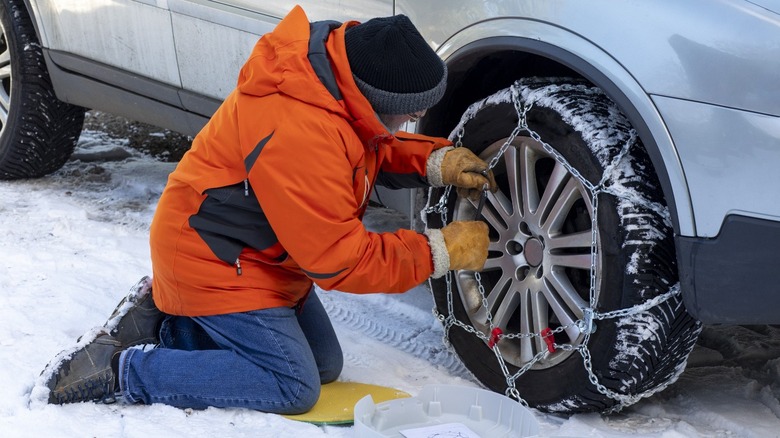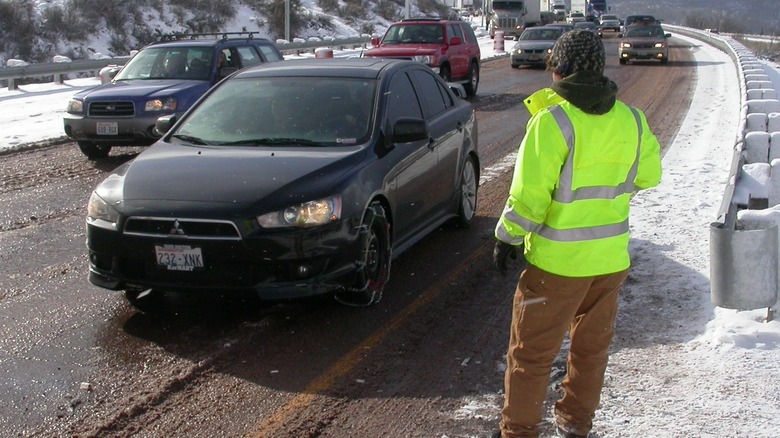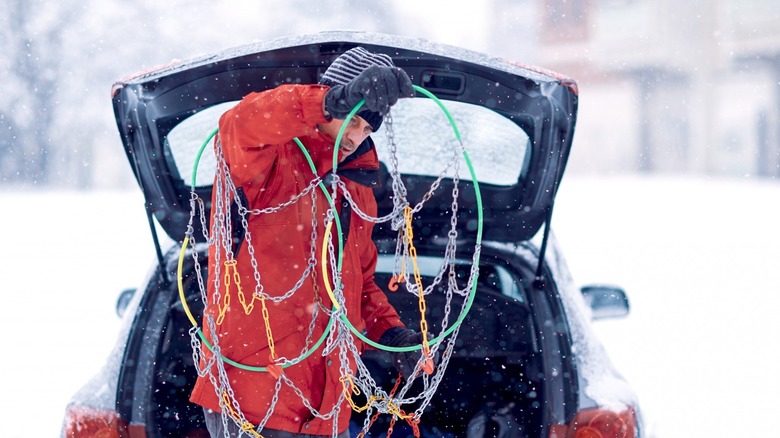What Are Tire Chains And When Should You Put Them On Your Car?
We may receive a commission on purchases made from links.
Anyone who lives in a snowy state probably already knows about tire chains. These seasonal tools are literal chains that wrap around tires to provide traction in the ice and snow, and they're an essential item for car emergency kits. They can be a lifesaver on wintry roads, but you should learn about their safe and proper usage to make sure you don't slip up when the snow starts falling.
Interestingly, tire chains are legal across all 50 states, including those that virtually never receive snow, like Florida and Hawaii. In fact, the Sunshine State doesn't even have restrictions on their usage, meaning you can legally cruise down Miami asphalt with your tires wrapped in chains. But you shouldn't. Tire chains on dry pavement can damage both roads and vehicles, and they can also be dangerous when improperly installed. That's why most states have specific legal guidelines regarding the permissible time of year and places where you can legally drive on chains.
Thus, even when you're following your state laws, you should only drive on tire chains when there's a layer of ice, snow, or sleet on the road, so stay aware of the weather hazards in your area. Most importantly, tire chains can significantly reduce a car's handling when used on ice-free surfaces. After all, state laws were created for a reason, but the laws of friction aren't optional.
When should you put on tire chains, and can you leave them on all winter?
In the right situations, tire chains can keep you mobile in the winter and even potentially save your life. In the wrong situations, they can be a serious hazard. So, your first step in determining when to use tire chains is to look up your state laws.
For example, New Jersey's legal guidelines reveal the main concerns surrounding tire chains:
"May be fitted with tire chains of reasonable proportions when roads, streets, and highways are slippery, because of rain snow, ice, oil, manner of construction or other reason; provided, however, that no tire chains shall be used at any time on improved highways when highway conditions do not make such use necessary for the safety of life or property. No person shall use any tire chains so constructed or installed as to be likely to be thrown so as to endanger any person or property."
These guidelines point toward three main concerns. One, tire chains can protect the "safety of life or property" when used on slippery roads where rain, snow, or ice is present. Two, if tire chains aren't necessary, they can be dangerous and shouldn't be used. Three, tire chains can fall off if improperly installed or poorly made, and this can cause accidents.
With these in mind, it will be clear when to use tire chains. Follow your state's laws, and only use them when roads are slippery. If they aren't, you should remove your chains. Leaving them on all winter long is only acceptible for areas where the roads are continuously icy for the whole season. Looking at you, Alaska.
[Featured image by Oregon Department of Transportation via Wikimedia Commons | Cropped and scaled | CC BY 2.0]
How do you safely install tire chains?
Unless your tires have built-in retractable chains, you should practice installing and removing your tire chains before you set off, since the side of the highway in a blizzard isn't the ideal place for first-timers. Fortunately, it's a straightforward procedure.
Before you start, ensure your chains are the correct size for your tires. The numbers on your tires indicate their size, so check each one and write them down before shopping. Some can be used on a range of tire sizes, such as this set from FlySwan. Refer to the listing's chart to see which model fits your tires.
Once you have compatible chains, inspect them for damage before installation. This includes rust, stuck chain links, dents, and serious scratches. Should you notice anything of questionable integrity, you'll have to buy a new set.
Working with each tire and chain at a time, lay the chain on the ground, making sure it's not tangled. Then, slip the chain over the tire so that its middle is centered at the highest point. Tuck the ends snuggly between the tire and the ground.
Next, drive about a foot forward until your tires roll over the chains, exposing the disconnected ends. Connect the ends by whichever connection style your chains utilize. Most have hooked ends and clips to tighten the chain. However, the designs vary, so refer to the manual if you're unsure.
Once your chains are installed, you're free to drive. As a final precaution, you can drive a few hundred yards, stop, and check each chain to make sure they're snug. You should notice significantly greater traction on icy roads but don't forget to remove your chains if the law or the weather demands it.


